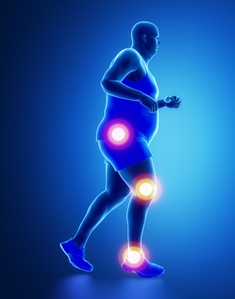Spine
How to exercise to lose weight when exercise is painful
High body mass index (BMI) is significant factor in low back pain, osteoarthritis; hip osteoarthritis; knee osteoarthritis, plantar heel pain. Weight loss intervention for pain reduction Decreasing body weight is an effective intervention to decrease musculoskeletal pain. Research by Stephen Messier at Wake Forest U, looking at individuals with painful osteoarthritis of the knee who…
Read More“Deme Bones” – Regional interdependence
The common reframe from the old spiritual song “dem bones” is the “toe bone is connected to foot bone”. In the medical community this concept of mechanical connectiveness is referred to as “regional interdependence”. Regional interdependence is seemingly unrelated impairments in remote anatomical regions of the body may contribute to and be associated with a…
Read MoreShoe drop – how the pendulum swings
Put on your high-heel sneakers, Lordy Wear your wig-hat on your head Put on your high-heel sneakers, child Wear your wig-hat on your head Ya know you’re looking mighty fine, baby I’m pretty sure you’re gonna knock ‘em dead – Tommy Tucker Growing up in the 1960s, I remember the song, “Put on Your High-Heel…
Read MoreKeeping the Spring in Your Step: Ankle Joint Power & Aging
http://bit.ly/DAMIEN25 As we amass more birthdays and get older we tend to walk/run slower, take shorter steps, and fewer per minute. Why do we seem to have less spring in our step the older we get? Kids move fast and crash elderly move slow and crash. One factor is kids have good ankle power elderly…
Read MoreLateral Pelvic Tilt Sitting
When oriented normally, the pelvis appears level and symmetrical. But in individuals with a lateral pelvic tilt (also called pelvic obliquity), one side of the pelvis appears lower than the other side. Lateral pelvic tilt can both cause and compensation to avoid musculoskeletal pain. It can be a contributing factor to jaw pain, headaches, shoulder,…
Read MoreOrthopedic Surgery vs Orthopedic Medicine: Considerations Regarding Elective Surgery
There is a difference between someone who practices orthopedic surgery and someone who practices orthopedic medicine. Orthopedic surgeons are interested in surgical treatment of musculoskeletal problems. Orthopedic medicine practitioners are interested in non-surgical treatment of musculoskeletal problems. Dr. James Cyriax, author of “Textbook of Orthopaedic Medicine,” emphasized this difference. While some orthopedic problems improve with…
Read MoreCuing to Alter Gait Deviation of Too Long a Step
Cuing to Alter Gait Deviation of Too Long a Step Mathematics helps explain walking or running faster. Step length X steps per minute = speed. In order to move faster there are 3 opportunities take longer steps or strides, increase the steps/minute (cadence), or do both longer steps and a faster cadence. Taking longer steps/stride…
Read MoreBack Pain Dilemma – Keep on Walking
Walking is commonly recommended by many medical professional associations for management of back pain. Walking is purported to be beneficial counteracting the potential deleterious effects of bed rest, maintaining functional abilities, stimulating use of spinal core muscles, keeping the general benefits of aerobic exercise, and providing pain reduction effects. Pain Walking can provide relief to…
Read MoreBody Proportions – Musculoskeletal Pain – Sports Performance
The importance of knowing how tall we are is somewhat obvious. What is less obvious is the importance of knowing the proportionality of our vertical height. The ideal proportionality of a human body’s stature was defined by Leonardo da Vinci. The “Vitruvian Man” or “drawing of proportions of man” is the ideal human proportions…
Read MoreHamstring, Buttock, Back, Neck Pain and the Car Seat
I frequently hear from my patients that their hamstring started hurting after they ran a marathon or that their back pain developed after they went body surfing at the beach. After closer questioning I discover that the problem did not occur during the marathon or while body surfing, but that it occurred afterwards during the…
Read More









